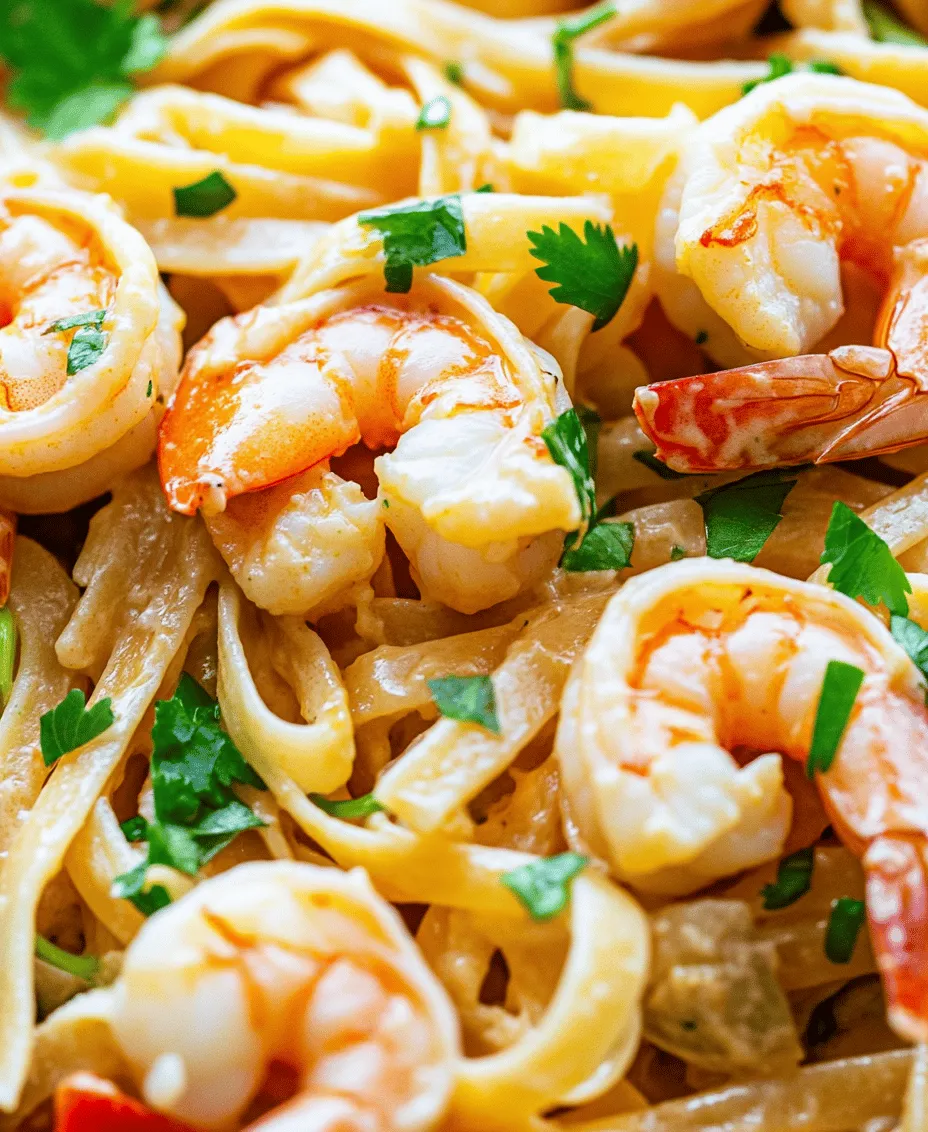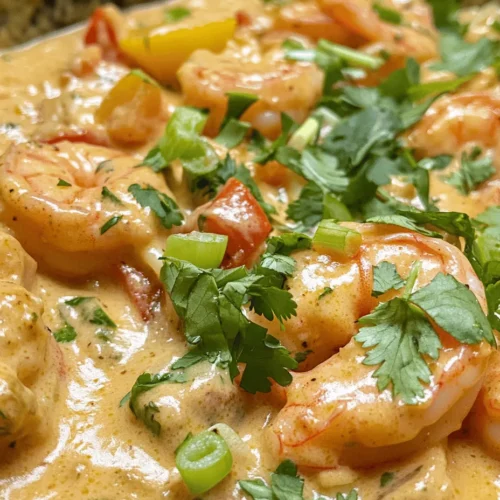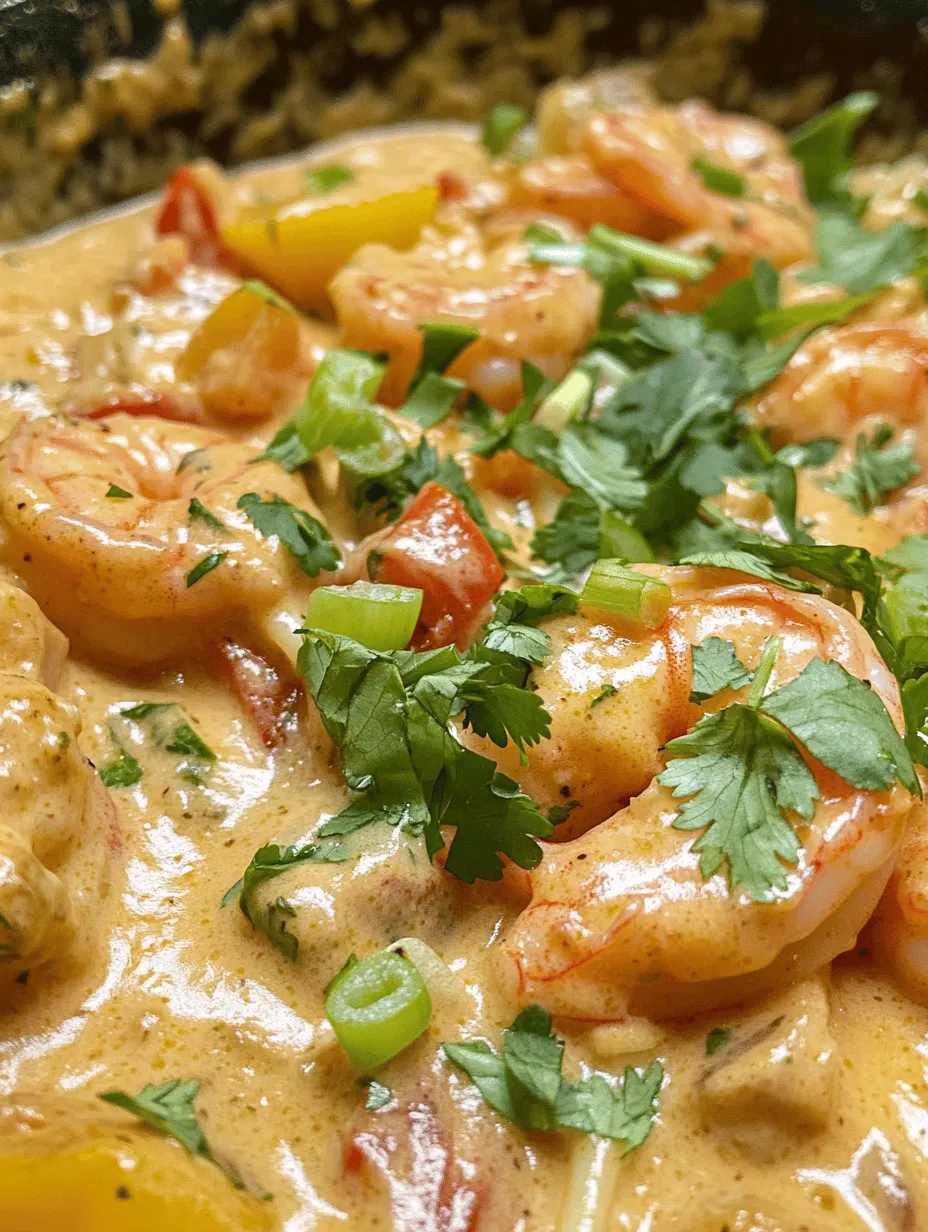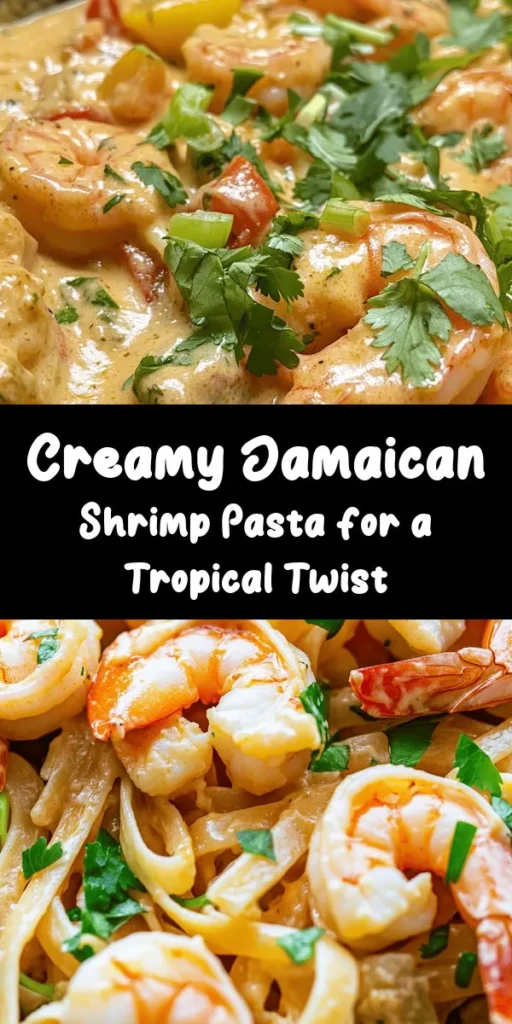Introduction
Explore the vibrant flavors of the Caribbean with our Jamaican Shrimp Pasta recipe, a creamy delight that combines succulent shrimp with a rich and aromatic sauce. This dish is not only a feast for the senses but also a quick and satisfying meal that can be prepared in just 30 minutes. Perfect for weeknight dinners or special occasions, this recipe captures the essence of Jamaican cuisine while offering a comforting twist with pasta.
In this article, we will delve into the ingredients, preparation, and the cultural influences that make this dish a must-try. Jamaican cuisine is renowned for its bold flavors, vibrant colors, and the ability to evoke the spirit of the islands. By merging the traditional elements of Jamaican cooking with the universal appeal of pasta, this dish creates a delightful fusion that is both familiar yet exotic.
Understanding Jamaican Cuisine
The Essence of Jamaican Flavors
At the heart of Jamaican cooking lies a unique blend of spices and fresh ingredients that create unforgettable tastes. Key components of Jamaican cuisine include allspice, scotch bonnet peppers, ginger, garlic, thyme, and a variety of herbs that contribute to the bold flavors we associate with this culinary tradition.
Allspice, known locally as “pimento,” is a quintessential spice in Jamaican cooking. Its complex flavor profile combines notes of cinnamon, nutmeg, and clove, allowing it to be used across both sweet and savory dishes. Meanwhile, the infamous scotch bonnet pepper is a staple that adds heat and depth to many recipes. This fiery pepper is a defining characteristic of Jamaican dishes, and its use in our shrimp pasta will ensure a vibrant kick.
In addition to spices, fresh vegetables are integral to Jamaican cuisine. Ingredients such as bell peppers, scallions, and tomatoes are commonly found in many dishes, providing not just flavor but also a burst of color and nutrition. The use of fresh produce not only enhances the taste but also reflects Jamaica’s agricultural abundance and commitment to using locally sourced ingredients.
The Role of Seafood in Jamaican Dishes
Seafood has long been a staple of Jamaican cuisine, rooted in the island’s geography and culture. Surrounded by water, Jamaica boasts an array of fresh fish and shellfish, making seafood an accessible and essential part of daily life. Historically, fishing has been a vital source of sustenance for many coastal communities, leading to the development of a rich tradition of seafood dishes.
Popular seafood dishes in Jamaica include escovitch fish, curried crab, and steamed mussels, each showcasing the island’s unique flavors and cooking techniques. These dishes often highlight the use of local spices and cooking methods, such as frying or steaming, that enhance the natural flavors of the seafood. In our Jamaican Shrimp Pasta, we pay homage to this tradition by incorporating fresh shrimp, allowing the dish to capture the essence of the Caribbean in every bite.
Ingredients Breakdown for Jamaican Shrimp Pasta
Fresh and Flavorful Components
To create an authentic Jamaican Shrimp Pasta, selecting the right ingredients is crucial. Here’s a closer look at the key components of this dish:
– Shrimp: The star of the dish, shrimp should be fresh or properly thawed if frozen. Opt for medium to large shrimp that are deveined and peeled for ease of preparation. Fresh shrimp not only provide a delightful texture but also absorb the flavors of the sauce beautifully.
– Pasta: Choose a pasta shape that can hold onto the sauce well; fettuccine or linguine works wonderfully in this recipe. Cooking the pasta to al dente ensures that it retains a slight bite, which will complement the creamy sauce.
– Vegetables: Bell peppers and scallions add a burst of color and crunch. These vegetables not only enhance the visual appeal of the dish but also contribute freshness and flavor.
– Garlic and Ginger: These aromatic ingredients lay the foundation for the sauce, infusing it with warmth and depth.
The Creamy Base
The luscious sauce that envelops our shrimp and pasta is a key element of this dish. The combination of coconut milk and heavy cream creates a rich and velvety texture that is both satisfying and indulgent.
– Coconut Milk: A staple in many Caribbean recipes, coconut milk brings a subtle sweetness and a hint of tropical flavor to the sauce. It is also dairy-free, making it a great alternative for those with lactose intolerance. Additionally, coconut milk is rich in nutrients, including healthy fats and vitamins, contributing to a well-rounded dish.
– Heavy Cream: While coconut milk provides the base, heavy cream adds an extra layer of richness. The combination of these two ingredients creates a balanced sauce that is creamy without being overly heavy.
Spice and Seasoning
To elevate the flavor profile of the Jamaican Shrimp Pasta, we will incorporate a blend of spices that are characteristic of Jamaican cooking.
– Allspice: As previously mentioned, allspice is a fundamental spice in Jamaican cuisine. It lends warmth and complexity to the sauce, enhancing the overall flavor.
– Paprika: This spice adds a mild smokiness and vibrant color to the dish, complementing the other spices without overpowering them.
– Thyme: Fresh or dried thyme brings a herbaceous note that balances the richness of the sauce, offering a delightful contrast.
– Scotch Bonnet Pepper Sauce: For those who enjoy a bit of heat, a splash of scotch bonnet pepper sauce will take this dish to the next level. While it’s optional, including this sauce will provide an authentic Jamaican flavor and a spicy kick that is sure to delight.
Step-by-Step Cooking Instructions
Now that we have an understanding of the ingredients that make our Jamaican Shrimp Pasta special, let’s dive into the step-by-step instructions for preparing this dish.
Preparing the Pasta
1. Boil Water: In a large pot, bring salted water to a boil. The salt is essential for flavoring the pasta; it should taste like seawater.
2. Cook the Pasta: Add the pasta to the boiling water and cook according to package instructions until al dente. This usually takes about 8-10 minutes, depending on the type of pasta used.
3. Reserve Pasta Water: Before draining the pasta, save about a cup of the starchy pasta water. This water is rich in flavor and can be added to the sauce later to adjust its consistency.
4. Drain and Set Aside: Drain the pasta and set it aside, ensuring it doesn’t sit in the hot water for too long, as this can lead to overcooking.
Sautéing the Shrimp to Perfection
1. Heat the Pan: In a large skillet or frying pan, heat a tablespoon of olive oil over medium-high heat. The oil should shimmer but not smoke, indicating it’s hot enough to sauté.
2. Add Shrimp: Once the oil is hot, add the fresh shrimp to the pan in a single layer. Avoid overcrowding the pan, as this can cause the shrimp to steam rather than sear.
3. Season the Shrimp: Sprinkle the shrimp with a pinch of salt, pepper, and half a teaspoon of allspice. This seasoning will help build flavor in the shrimp as they cook.
4. Cook Until Pink: Sauté the shrimp for 2-3 minutes on one side until they turn pink and opaque. Flip the shrimp over to cook the other side for another minute or two. Be careful not to overcook, as shrimp can become rubbery.
5. Remove and Set Aside: Once cooked, remove the shrimp from the skillet and set them aside on a plate. This step ensures they don’t continue cooking in the residual heat of the pan.
As we progress further into this recipe, we’ll explore how to create the luscious sauce that ties all these wonderful ingredients together, complementing the shrimp and pasta in the most delicious way. The next steps will involve building those flavors, integrating the spices, and creating a harmonious dish that captures the essence of Jamaican cuisine. Stay tuned for the continuation of this culinary journey!

Techniques for Achieving Perfectly Cooked Shrimp
Cooking shrimp to perfection is an essential step in making Jamaican shrimp pasta truly delicious. The key to achieving tender, juicy shrimp lies in understanding timing and temperature. Begin by ensuring your shrimp are fresh or properly thawed if frozen. Pat them dry with a paper towel to remove excess moisture; this allows for better searing.
When cooking, heat a skillet over medium-high heat and add a splash of oil. The oil should shimmer but not smoke—this indicates that the pan is hot enough to sear the shrimp. Add the shrimp in a single layer, ensuring they don’t overcrowd the pan. This allows them to cook evenly and develop a beautiful golden crust. Cook for 2-3 minutes on one side without moving them, then flip and cook for an additional 1-2 minutes until they turn pink and opaque. Overcooking shrimp can lead to a rubbery texture, so keep a close eye on them. Once cooked, remove the shrimp from the pan and set them aside while you prepare the sauce.
Importance of Seasoning at This Stage
Seasoning is a crucial element when preparing shrimp. Before cooking, sprinkle them with salt, pepper, and a pinch of paprika or cayenne for a hint of heat. You can also marinate the shrimp in a mixture of lime juice, garlic, and jerk seasoning for 30 minutes before cooking to enhance their flavor. This step infuses the shrimp with the vibrant spices typical of Jamaican cuisine, setting the stage for a rich, layered flavor profile in your dish.
Crafting the Creamy Sauce
Sautéing Vegetables for Flavor Enhancement
The creamy sauce is where the magic happens in Jamaican shrimp pasta. Start by sautéing aromatic vegetables to build a robust flavor base. In the same skillet used for the shrimp, add a bit more oil if necessary and toss in finely chopped onions and bell peppers. Sauté these for about 3-5 minutes over medium heat until they soften and become fragrant. The sweetness of the onions combined with the pepper’s freshness creates a delightful foundation for your sauce.
Next, add minced garlic and ginger, sautéing for an additional minute. These ingredients add depth and a hint of warmth that complements the shrimp beautifully. Once your vegetables are perfectly sautéed, deglaze the pan with a splash of white wine or broth, scraping up any flavorful bits stuck to the bottom.
Timing and Temperature Control for Melding Flavors
Once the vegetables are sautéed, lower the heat slightly and introduce coconut milk to the pan. The creaminess of the coconut milk is a hallmark of Jamaican cuisine, providing a rich consistency that binds the dish together. Stir to combine, and allow the mixture to simmer gently. This is the time to add spices like thyme, allspice, and a sprinkle of nutmeg—these are essential to achieving that authentic Jamaican flavor.
Simmer the sauce for about 5-7 minutes, allowing it to thicken slightly. You want the flavors to meld together harmoniously, so avoid boiling the sauce aggressively. Adjust the heat as needed to maintain a gentle simmer, ensuring that the richness of the coconut milk is preserved while enhancing the flavors of the added spices.
Combining Ingredients for the Final Dish
Techniques for Integrating Pasta, Shrimp, and Sauce
With your sauce simmering beautifully, it’s time to combine the cooked pasta and shrimp. Cook your pasta of choice—linguine or fettuccine works well—according to package instructions until al dente. Reserve a cup of the pasta cooking water before draining the rest. This starchy water is instrumental in adjusting the sauce’s consistency.
Once the pasta is cooked, add it directly to the skillet with the sauce, tossing to combine. Introduce the cooked shrimp back into the mix, ensuring each piece is coated in the creamy sauce. If the sauce appears too thick, gradually add some reserved pasta water until you reach your desired consistency. Be cautious not to overdo it; you want a creamy texture that clings to the pasta without being soupy.
Adjusting Sauce Consistency and Flavor Balance with Lime Juice
At this stage, it’s important to balance the flavors. Squeeze fresh lime juice over the pasta and shrimp just before serving. The acidity of the lime brightens the dish, cutting through the richness of the coconut milk and enhancing the overall flavor profile. Taste the dish and adjust the seasoning as necessary, adding more salt, pepper, or spices to suit your palate.
Garnishing and Presentation
The Final Touches
Presentation can elevate your Jamaican shrimp pasta from a simple meal to a culinary masterpiece. Start by garnishing the dish with freshly chopped green onions and a sprinkle of cilantro or parsley. These herbs add a pop of color and freshness that complements the creamy sauce beautifully. For an extra touch, consider adding a few slices of lime on the side for a visual appeal and a hint of zesty flavor.
When plating, use a large, shallow bowl or a deep plate to give your dish room to breathe. Twirl the pasta into a nest in the center of the dish, arranging the shrimp artfully on top. Drizzle some of the creamy sauce over the shrimp and pasta, ensuring that the vibrant colors of the dish are visible. A well-presented plate enhances the dining experience, making it more inviting and appetizing.
Serving Suggestions
Ideal Pairings with Sides or Beverages
Jamaican shrimp pasta is a versatile dish that pairs wonderfully with a variety of sides and beverages. Consider serving it alongside a simple green salad dressed with a light vinaigrette to contrast the richness of the pasta. For a heartier option, cornbread or rice can complement the dish beautifully, absorbing the creamy sauce and balancing the meal.
To drink, a chilled glass of white wine, such as Sauvignon Blanc or a light-bodied Chardonnay, pairs well with the shrimp and creamy sauce. If you prefer non-alcoholic options, a refreshing coconut water or homemade lemonade can enhance the tropical flavors of the dish.
How to Adjust the Heat Level for Different Palates
One of the joys of cooking at home is the ability to tailor dishes to your personal tastes. If you or your guests enjoy a bit of spice, consider adding sliced jalapeños or a dash of hot sauce to the pasta before serving. For those who prefer a milder dish, you can reduce the amount of jerk seasoning used in the marinade or omit it altogether, relying on the other flavors to shine through.
Nutritional Information
Health Benefits of the Ingredients
Jamaican shrimp pasta is not only delicious but also packed with health benefits. Shrimp is an excellent source of lean protein, providing essential amino acids without excessive calories. It’s also rich in selenium and vitamin B12, which are important for metabolic processes and maintaining energy levels.
Coconut milk adds healthy fats, particularly medium-chain triglycerides (MCTs), which can offer quick energy and support heart health. The inclusion of vegetables like bell peppers and onions contributes essential vitamins and minerals, making this dish a well-rounded meal.
Serving Size and Portion Control
When serving Jamaican shrimp pasta, a suggested portion is about 1-1.5 cups per person, depending on appetite and dietary needs. This serving size typically contains around 400-500 calories, making it a satisfying yet manageable option for dinner. For those with dietary restrictions, consider using gluten-free pasta or adjusting the recipe to fit vegan preferences by substituting shrimp with plant-based proteins.
Conclusion
Jamaican Shrimp Pasta is more than just a meal; it’s an experience that encapsulates the rich culinary heritage of Jamaica. With its creamy sauce, vibrant spices, and tender shrimp, this dish offers a delightful combination of flavors that will transport your taste buds to the tropics. Whether you’re looking for a quick weeknight dinner or an impressive dish to serve guests, this recipe is sure to satisfy. Embrace the Caribbean spirit and enjoy the comforting taste of Jamaican cuisine right in your own kitchen.



